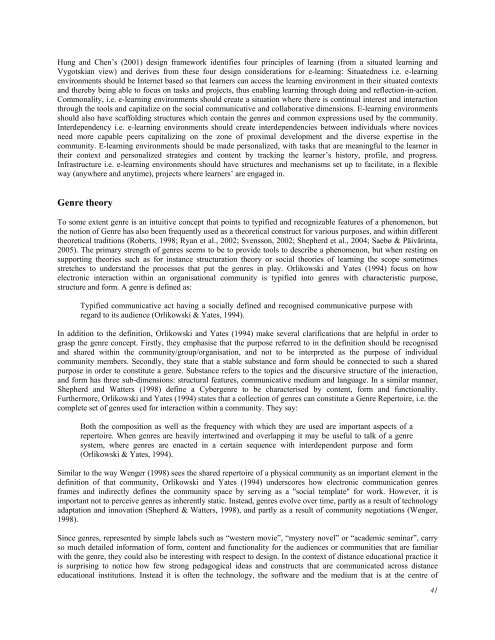October 2007 Volume 10 Number 4 - Educational Technology ...
October 2007 Volume 10 Number 4 - Educational Technology ...
October 2007 Volume 10 Number 4 - Educational Technology ...
Create successful ePaper yourself
Turn your PDF publications into a flip-book with our unique Google optimized e-Paper software.
Hung and Chen’s (2001) design framework identifies four principles of learning (from a situated learning and<br />
Vygotskian view) and derives from these four design considerations for e-learning: Situatedness i.e. e-learning<br />
environments should be Internet based so that learners can access the learning environment in their situated contexts<br />
and thereby being able to focus on tasks and projects, thus enabling learning through doing and reflection-in-action.<br />
Commonality, i.e. e-learning environments should create a situation where there is continual interest and interaction<br />
through the tools and capitalize on the social communicative and collaborative dimensions. E-learning environments<br />
should also have scaffolding structures which contain the genres and common expressions used by the community.<br />
Interdependency i.e. e-learning environments should create interdependencies between individuals where novices<br />
need more capable peers capitalizing on the zone of proximal development and the diverse expertise in the<br />
community. E-learning environments should be made personalized, with tasks that are meaningful to the learner in<br />
their context and personalized strategies and content by tracking the learner’s history, profile, and progress.<br />
Infrastructure i.e. e-learning environments should have structures and mechanisms set up to facilitate, in a flexible<br />
way (anywhere and anytime), projects where learners’ are engaged in.<br />
Genre theory<br />
To some extent genre is an intuitive concept that points to typified and recognizable features of a phenomenon, but<br />
the notion of Genre has also been frequently used as a theoretical construct for various purposes, and within different<br />
theoretical traditions (Roberts, 1998; Ryan et al., 2002; Svensson, 2002; Shepherd et al., 2004; Saebø & Päivärinta,<br />
2005). The primary strength of genres seems to be to provide tools to describe a phenomenon, but when resting on<br />
supporting theories such as for instance structuration theory or social theories of learning the scope sometimes<br />
stretches to understand the processes that put the genres in play. Orlikowski and Yates (1994) focus on how<br />
electronic interaction within an organisational community is typified into genres with characteristic purpose,<br />
structure and form. A genre is defined as:<br />
Typified communicative act having a socially defined and recognised communicative purpose with<br />
regard to its audience (Orlikowski & Yates, 1994).<br />
In addition to the definition, Orlikowski and Yates (1994) make several clarifications that are helpful in order to<br />
grasp the genre concept. Firstly, they emphasise that the purpose referred to in the definition should be recognised<br />
and shared within the community/group/organisation, and not to be interpreted as the purpose of individual<br />
community members. Secondly, they state that a stable substance and form should be connected to such a shared<br />
purpose in order to constitute a genre. Substance refers to the topics and the discursive structure of the interaction,<br />
and form has three sub-dimensions: structural features, communicative medium and language. In a similar manner,<br />
Shepherd and Watters (1998) define a Cybergenre to be characterised by content, form and functionality.<br />
Furthermore, Orlikowski and Yates (1994) states that a collection of genres can constitute a Genre Repertoire, i.e. the<br />
complete set of genres used for interaction within a community. They say:<br />
Both the composition as well as the frequency with which they are used are important aspects of a<br />
repertoire. When genres are heavily intertwined and overlapping it may be useful to talk of a genre<br />
system, where genres are enacted in a certain sequence with interdependent purpose and form<br />
(Orlikowski & Yates, 1994).<br />
Similar to the way Wenger (1998) sees the shared repertoire of a physical community as an important element in the<br />
definition of that community, Orlikowski and Yates (1994) underscores how electronic communication genres<br />
frames and indirectly defines the community space by serving as a "social template" for work. However, it is<br />
important not to perceive genres as inherently static. Instead, genres evolve over time, partly as a result of technology<br />
adaptation and innovation (Shepherd & Watters, 1998), and partly as a result of community negotiations (Wenger,<br />
1998).<br />
Since genres, represented by simple labels such as “western movie”, “mystery novel” or “academic seminar”, carry<br />
so much detailed information of form, content and functionality for the audiences or communities that are familiar<br />
with the genre, they could also be interesting with respect to design. In the context of distance educational practice it<br />
is surprising to notice how few strong pedagogical ideas and constructs that are communicated across distance<br />
educational institutions. Instead it is often the technology, the software and the medium that is at the centre of<br />
41

















